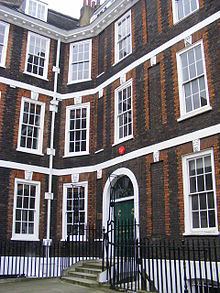 | ||
Queen Anne’s Gate is a street in Westminster, London. Many of the buildings are Grade I listed, known for their Queen Anne architecture (5-13; 14-22; 15; 17/19; 21/23; 25; 26-32; 34; 40; 42; 44; 46; Statue of Queen Anne).
Contents
Location
Queen Anne’s Gate runs from Old Queen Street in the east to a cul-de-sac in the west. It runs parallel with Birdcage Walk to the north and Petty France, Broadway and Tothill Street to the south. Carteret Street joins Queen Anne’s Gate on its southern side.
History
In 1874 Park Street and Queen Square were renumbered and renamed Queen Anne's Gate.
Occupants and buildings
The street is home to:
Old Queen Street
Old Queen Street is a continuation of Queen Anne’s Gate, connecting it to Storey’s Gate. It was first laid out with townhouses in the late 18th century, and is home to many institutions, including the National Crime Agency and the European Council on Foreign Relations.
